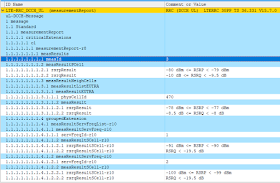Last week I read in Martin Sauter's blog about the LTE RRC A6 measurement event.
Although I am quite interested in RRC measurements I have never seen the A6 event in action. Rather the eNB vendors have implemented carrier aggregation in a way that the UE provides its capabilities and according to the this the maximum possible numbers of component carriers is added to the connection. There is no RRC measurement report before adding secondary LTE cells to the connection. So what is the A6 event good for and is it used at all?
Surprisingly I needed only 2 attempts to find an example of using the A6 event in a live network configuration. It is used when more component carriers are available than the UE can simultaneously handle. E.g. if there are 4 or more cells with different carrier frequencies available in the same antenna sector the A6 event ensures after the initial CA configuration that the cells with the best radio conditions are selected as secondary cells.
 |
| Figure 1: Report Configuration for Event A6 |
The next step is the configuration of the Measurement ID as shown in figure 2. Here the reportConfigId is combined with a measObjectId that represents the carrier frequency of the potential SCell.
 |
| Figure 2: Measurement ID for Event A6 |
 |
| Figure 3: RRC Measurement Report for Event A6 |
There we see the RSRP and RSRQ of the primary cell (PCell) and of the currently serving secondary cells (SCells). By the way the servFreqId stands for the sCellIndex value that was linked to the physical cell ID (PCI) when this SCell was added in a previous RRC Connection Reconfiguration procedure.
And as one can see the neighbor cell with PCI = 470 has significantly better RSRP and RSRQ to offer than both currently used SCell.
Consequently the eNB decides to replace the SCell with sCellIndex value 1 with the better cell (PCI 470). This is again done with a RRC Connection Reconfiguration procedure as shown in figure 4. And this is the way how the A6 event is used.
 |
| Figure 4: Change of SCell |
Crystal clear explanation!
ReplyDeleteThank you Sir!
Superb explanation
ReplyDelete